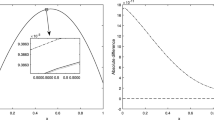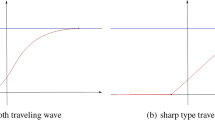Abstract
The finite-difference time-domain (FDTD) method, which is often used to solve Maxwell’s equations, has been proposed to solve the optical diffusion equations to simulate light propagation in turbid media such as biological tissue. Finite-difference methods can be numerically unstable and calculation can diverge unless a stability condition is satisfied. Until now, the stability condition for FDTD of the optical diffusion equations has not been derived. In this paper, we derive a stability condition for FDTD of the optical diffusion equations using the von Neumann stability analysis and verify the condition numerically.


Similar content being viewed by others
References
Adams, M.L., Larsen, E.W.: Fast iterative methods for discrete ordinates particle transport calculations. Prog. Nucl. Energy 40, 3 (2002)
Fletcher, J.K.: A solution of the neutron transport equation using spherical harmonics. J. Phys. A Math. Gen. 16, 2827 (1983)
Kobayashi, K., Oigawa, H., Yamagata, H.: The spherical harmonics method for the multigroup transport equation in x-y geometry. Ann. Nucl. Energy 13, 663 (1986)
Klose, A.D., Larsen, E.W.: Light transport in biological tissue based on the simplified spherical harmonics equations. J. Comput. Phys. 220, 441 (2006)
Jha, A.K., Kupinski, M.A., Masumura, T., Clarkson, E., Maslov, A.A., Barrett, H.H.: Simulating photon-transport in uniform media using the radiative transfer equation: a study using the Neumann-series approach. J. Opt. Soc. Am. A. 29, 1741 (2012)
Arridge, S.R.: Optical tomography in medical imaging. Inverse Probl. 15, R41–R93 (1999)
Martelli, F., Bianco, S.D., Ismaelli, A., Zaccanti, G.: Light Propagation through Biological Tissue and Other Diffusive Media. SPIE Press, Washington (2010)
Arridge, S.R., Schweiger, M., Hiraoka, M., Delpy, D.T.: A finite element approach for modeling photon transport in tissue. Med. Phys. 20, 299 (1993)
Hielscher, A.H., Klose, A.D., Hanson, K.M.: Gradient-based iterative image reconstruction scheme for time-resolved optical tomography. IEEE Trans. Med. Imaging 18, 262 (1999)
Tanifuji, T., Hijikata, M.: Finite difference time domain (FDTD) analysis of optical pulse responses in biological tissues for spectroscopic diffused optical tomography. IEEE Trans. Med. Imaging 21, 181 (2002)
Taflove, A., Hagness, S.C.: Computational Electrodynamics the Finite-difference Time-domain Method, 3rd edn. Artech House, Norwood (2005)
Hirsch, C.: Numerical Computation of Internal and External Flows, Fundamentals of Numerical Discretization, vol. 1. Wiley, New York (1989)
Richtmyer, R.D., Morton, K.W.: Difference Methods for Initial-Value Problems, 2nd edn. Wiley-Interscience, New York (1967)
Acknowledgements
We wish to thank Dr. Daniel G. Smith and Setsuko Iwami of Nikon Research Corporation of America (NRCA) and Yuichi Takigawa for their great help.
Author information
Authors and Affiliations
Corresponding author
Additional information
Publisher's Note
Springer Nature remains neutral with regard to jurisdictional claims in published maps and institutional affiliations.
Appendices
Appendix 1: Proof of inequalities (10) and (11)
In this appendix, we prove the inequalities (10) and (11). We rewrite these inequalities below:
We do not need to know the value \(| \gamma _ +|\) as \(\upsilon \varDelta t > 1/\sqrt{P}\). Whether the value \(| \gamma _ +|\) is less than one or not; this FDTD is unstable when \(\upsilon \varDelta t > 1/\sqrt{P}\), because the other eigenvalue \(| \gamma _ -|\) is larger than one as we prove below. Substituting Eqs. (3) and (6) into Eq. (9):
where
Now, substituting \(\upsilon \varDelta t = 1/\sqrt{P}\) into Eq. (19), we get:
Around \(\upsilon \varDelta t = 1/\sqrt{P}\), \(\gamma _-\) can be larger than one, and hence, \(\upsilon \varDelta t = 1/\sqrt{P}\) is the candidate for stability bound. Considering the function \(\left| {\frac{{2 - x}}{{2 + x}}} \right| \,\,\,{\text {as}}\,\,x > 0\), we get \(\left| {{{\left. {\,\,{\gamma _ + }} \right| }_{\upsilon \varDelta t = 1/\sqrt{P} }}} \right| < 1\).
The square root in \(g_2\) is zero if
Then, we define \(\beta _r\) by:
Since we know that \({\left( {{\mu _{tr}} - {\mu _a}} \right) ^2} > 0\) and \(\mu _a\), \(\mu _{tr}>0\):
Therefore, the region over which \(g_2\) is not real is smaller than \(\upsilon \varDelta t = 1/\sqrt{P}\). Figure 3 depicts this relation. Note that if \(16P \le {\left( {{\mu _{tr}} - {\mu _a}} \right) ^2}\), then \(g_2\) is real for any \(\upsilon \varDelta t>0\).
If we can prove the states (A1) and (A2) below, we show that \(|\gamma _{\pm }|\le 1\) as \(\upsilon \varDelta t \le 1/\sqrt{P}\), and (A3) leads \(|\gamma _{\pm }|>1\) as \(\upsilon \varDelta t > 1/\sqrt{P}\). We can, therefore, prove what we set out to prove in this appendix.
- (A1)
\(|\gamma _\pm | < 1\quad\) as \(\quad 0<\upsilon \varDelta t \le \beta _r\).
- (A2)
\(| \gamma _+|< 1,| \gamma _-| < 1 \quad\) as \(\quad \upsilon \varDelta t \in \left( \beta _r,1/\sqrt{P}\right)\).
- (A3)
\(\gamma _{-}=-1\) as \(\upsilon \varDelta t = 1/\sqrt{P}\), and \(\gamma _-\) monotonically decreases as \(\upsilon \varDelta t > {\beta _r}\)
Proof of (A1)
We can obtain \(|\gamma _\pm |^2\) from Eq. (19):
function \(\left| {\frac{{2 - x}}{{2 + x}}} \right|\) is less than unity as \(x>0\), and therefore, as we have considered in Eq. (21a), we get \(\left| {{\gamma _ \pm }} \right| < 1\).
Proof of (A2)
As for \({\gamma _ + } = {g_1} + {g_2}\), \(\left| {{\gamma _ + }} \right| = \left| {{g_1} + {g_2}} \right| \le + 1\) is equivalent to two inequalities \(- 1 - {g_1} \le {g_2}\) and \({g_2} \le 1 - {g_1}\). First, we show \(- 1 - {g_1} \le {g_2}\). Consider the region \(\upsilon \varDelta t < 1/\sqrt{P}\), so that \(1 - {\upsilon ^2}\varDelta {t^2}P > 0\), and
Because apparently \(g_2>0\), so that \(- 1 - {g_1} \le {g_2}\). Next, we want to show that \(- 1 - {g_1} \le {g_2}\), and so we can calculate:
Therefore \({g_2}^2 \le {\left( {1 - {g_1}} \right) ^2}\). \(g_2\) is positive and
because all the parameters in this equation are positive. Since the square function is an increasing monotonic function in the positive domain, we have \({g_2} \le 1 - {g_1}\). We have shown that \(\left| {{\gamma _ + }} \right| \le 1\) as \(\upsilon \varDelta t \in \left( {{\beta _r},1/\sqrt{P} } \right)\). Although it is omitted here, the bound on \(\gamma _-\) can be shown in the same way.
Proof of (A3)
We have shown that \(\gamma _-=-1\) as \(\upsilon \varDelta t = 1/ \sqrt{P}\) in Eq. (21b), so it only remains to show that \(\gamma _-\) monotonically decreases as for \(\upsilon \varDelta t\).
Differentiating \({g_2}^2\) with respect to \(\upsilon \varDelta t > 0\):
Therefore, \({g_2}^2\) is monotonically increasing. Because \(g_2>0\), \(g_2\) is also monotonically increasing.
Differentiating \(g_1\):
shows that \(g_1\) is monotonically decreasing and \(\gamma _-=g_1-g_2\) is also monotonically decreasing.
Appendix 2: The other results of the simulation of the different initial distribution
As shown in Sect. 3, the stability condition depends on the dimensions of the field; \(\lambda =\sqrt{3}\) in 1D, and \(\lambda =\sqrt{3/2}\) in 2D. We, therefore, include the results of the simulation in these dimensions. We use the same simulation parameters as in Sect. 4 except that the initial conditions, as stated in Eq. (18) for the 3-D case, become Eqs. (30a) and (30b) for 1-D and 2-D, respectively:
where \(p_x\) and \(p_y\) are the period of the initial distribution along each axis and we put \({p_x} = {p_y} = 20\varDelta x\). As in the 3D simulation, we choose the Courant numbers to be 1% larger and 1% lower than the stability bound. Figure 4 shows that the results again support the boundary condition expressed by Eq. (17).
Simulation results around stability bound in 1D and 2D. The peak-to-valley (P–V) of \(\varPhi\) in each time-step a with the 1D initial distribution expressed by Eq. (30a) and b with the 2D initial distribution expressed by Eq. (30b). Open square: \(\lambda = 0.99\sqrt{3/d}\), diagonal cross: \(\lambda = 1.01\sqrt{3/d}\), and dashed line is \(C |\gamma _-|^n\). \({\gamma _-} \cong - 1.0872\) when \(\lambda =1.01 \sqrt{3}\) in 1D simulation, and \({\gamma _ - } \cong - 1.1162\) when \(\lambda =1.01 \sqrt{3/2}\) in 2D-simulation. The dotted line indicates the theoretical amplitude
Appendix 3: The theoretical curve in the single-mode distribution in the first numerical simulation
In this appendix, we calculate the time dependence of the peak-to-valley when the initial distribution is expressed by Eq. (18).
Because the diffusion equations are linear, we only need to consider these terms:
where \(b_\phi\) and \(b_j\) depend only on time. \(p_x\) is a spatial frequency.
Substitute the above equations into:
We then obtain:
This differential equation is solved by orthogonalizing the matrix in this equation:
where
We then obtain the solution with the initial values \(b_\phi =1\) and \(b_j=b_j^0\) at \(t=0\):
In the simulation described in the article, we can use \(b_j^0\), and from the (1,1)-element of \({P^{ - 1}}\exp \left( { - \upsilon \Lambda t} \right) P\), we have the solution of the differential equation:
where \(\eta = \sqrt{9p_x^2{{\left( {{\mu _a} - {\mu _{tr}}} \right) }^2} - 48{\pi ^2}}\)
Finally, we obtain the theoretical time dependence of peak-to-valley as:
When \(p_x>0\), this value is exponentially increasing as t increases, and this expression shows that the increasing rate becomes higher as the spatial period \(p_x\) becomes smaller. This is the reason why the error forms the checkerboard pattern whose spatial frequency is the highest in the 2D image, as shown in Fig. 1b or Fig. 2.
Rights and permissions
About this article
Cite this article
Toba, H., Odate, S., Otaki, K. et al. The stability condition for the FDTD of the optical diffusion equations. Opt Rev 27, 81–89 (2020). https://doi.org/10.1007/s10043-019-00567-7
Received:
Accepted:
Published:
Issue Date:
DOI: https://doi.org/10.1007/s10043-019-00567-7






